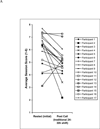Does simulator-based clinical performance correlate with actual hospital behavior? The effect of extended work hours on patient care provided by medical interns
- PMID: 20881679
- PMCID: PMC3754850
- DOI: 10.1097/ACM.0b013e3181f073f0
Does simulator-based clinical performance correlate with actual hospital behavior? The effect of extended work hours on patient care provided by medical interns
Abstract
Purpose: The correlation between simulator-based medical performance and real-world behavior remains unclear. This study explored whether the effects of extended work hours on clinical performance, as reported in prior hospital-based studies, could be observed in a simulator-based testing environment.
Method: Intern volunteers reported to the simulator laboratory in a rested state and again in a sleep-deprived state (after a traditional 24- to 30-hour overnight shift [n=17]). A subset also presented after a shortened overnight shift (16 scheduled hours [n=8]). During each laboratory visit, participants managed two critically ill patients. An on-site physician scored each case, as did a blinded rater later watching videotapes of the performances (score=1 [worst] to 8 [best]; average of both cases=session score).
Results: Among all participants, the average simulator session score was 6.0 (95% CI: 5.6-6.4) in the rested state and declined to 5.0 (95% CI: 4.6-5.4) after the traditional overnight shift (P<.001). Among those who completed the shortened overnight shift, the average postshift simulator session score was 5.8 (95% CI: 5.0-6.6) compared with 4.3 (95% CI: 3.8-4.9) after a traditional extended shift (P<.001).
Conclusions: In a clinical simulation test, medical interns performed significantly better after working a shortened overnight shift compared with a traditional extended shift. These findings are consistent with real-time hospital studies using the same shift schedule. Such an independent correlation not only confirms the detrimental impact of extended work hours on medical performance but also supports the validity of simulation as a clinical performance assessment tool.
Figures



References
-
- Reznick RK, MacRae H. Teaching surgical skills—Changes in the wind. N Engl J Med. 2006;355:2664–2669. - PubMed
-
- Wayne DB, Didwania A, Feinglass J, Fudala MJ, Barsuk JH, McGaghie WC. Simulation-based education improves quality of care during cardiac arrest team responses at an academic teaching hospital: A case-control study. Chest. 2008;133:56–61. Epub 2007 Jun 15. - PubMed
-
- Gordon JA, Tancredi DN, Binder WD, Wilkerson WM, Shaffer DW. Assessment of a clinical performance evaluation tool for use in a simulator-based testing environment: A pilot study. Academic Medicine. 2003;78:S45–S47. - PubMed
-
- Berkenstadt H, Ziv A, Gafni N, Sidi A. Incorporating simulation-based objective structured clinical examination into the Israeli National Board Examination in Anesthesiology. Anesth Analg. 2006;102:853–858. - PubMed
-
- Gallagher AG, Cates CU. Approval of virtual reality training for carotid stenting: What this means for procedural-based medicine. JAMA. 2004;292:3024–3026. - PubMed
Publication types
MeSH terms
Grants and funding
LinkOut - more resources
Full Text Sources
Medical

